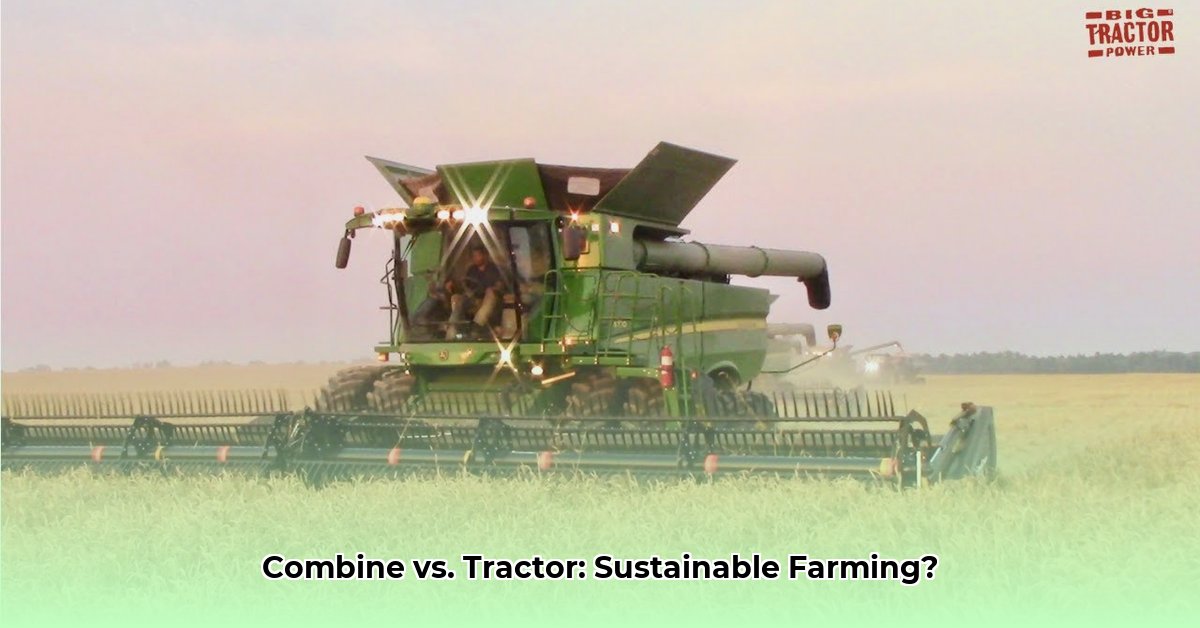
Choosing the right machinery is crucial for farmers aiming for both profitability and environmental responsibility. Tractors and combines, while both essential, serve distinct purposes and carry different implications for sustainable agriculture. This guide helps you weigh their advantages and disadvantages to make an informed decision. For more information on tractor operation, see our guide on tractor operation.
Understanding the Machinery Landscape
Tractors are versatile workhorses, vital for tasks like plowing, planting, and fertilizing throughout the growing season. They represent a significant investment, but their adaptability makes them a valuable asset across diverse farming operations. Combines, conversely, are specialized machines designed solely for harvesting grain crops such as wheat, corn, and soybeans. Their efficiency in harvesting is unmatched, minimizing crop loss and maximizing yield during the crucial harvest period. But this specialization comes at the cost of versatility.
Comparative Analysis: Tractor vs. Combine
This detailed comparison highlights key factors relevant to sustainable farming practices. Note that specific models will vary.
| Feature | Tractor | Combine Harvester | Sustainability Considerations |
|---|---|---|---|
| Upfront Cost | Generally lower | Significantly higher | Consider the return on investment (ROI) and financing options over the machine's lifespan. |
| Fuel Efficiency | Varies greatly depending on size, age, and tasks; newer models offer considerable improvements. | Typically higher fuel consumption during the intensive harvest period. | Prioritize fuel-efficient models and implement precision farming techniques to minimize fuel usage per acre. |
| Maintenance Needs | Generally less frequent and less costly unless using highly specialized equipment. | More frequent and complex maintenance often requiring specialized technicians; preventative maintenance is crucial. | Regular maintenance is essential for both to extend lifespan and reduce downtime; consider preventative maintenance contracts. |
| Environmental Impact | Lower per task, but cumulative impact can be substantial. | Higher during harvest season due to fuel consumption; manufacturing and disposal also contribute. | Choose models with lower emissions (e.g., Tier 4 engines); explore environmentally responsible disposal and recycling options. |
| Versatility | Very high; adaptable to a wide range of tasks using various attachments. | Very low; primarily designed for grain harvesting. | A tractor’s adaptability benefits farmers cultivating diverse crops or needing year-round functionality. |
| Impact on Crop Yield | Indirect; supports healthy crop growth through timely tillage, planting, and other activities. | Direct; minimizes grain loss during harvest, maximizing yield. | Efficient resource utilization is key; minimal waste is crucial for both environmental and economic sustainability. |
Lifecycle Cost Analysis: A Deeper Dive
Comparing tractor and combine harvester lifecycle costs for sustainable farming requires a comprehensive approach. It's not just the initial purchase; long-term costs are crucial.
- Initial Investment: Combines have substantially higher upfront costs than tractors. This initial investment significantly impacts long-term financial planning. Tractor prices vary widely depending on size, features, and brand.
- Fuel Efficiency: Fuel consumption is a major operational expense for both. Newer models often incorporate fuel-saving technologies. Direct comparison of fuel consumption rates (gallons per acre) is essential for cost-benefit analysis.
- Maintenance & Repair: Combines necessitate more frequent and potentially more expensive maintenance due to their complex machinery. Regular servicing programs for both are crucial to reduce unexpected breakdowns and maximize operational uptime.
- Environmental Impact: Fuel consumption is a major contributor to a machine's environmental footprint. Manufacturing and disposal further contribute to the overall impact. Consider life cycle assessments to fully understand the environmental implications.
Stakeholder-Specific Guidance
The optimal choice depends fundamentally on the specific needs and context of the farming operation.
1. Small Farms (<500 acres): A fuel-efficient tractor with adaptable attachments is typically the most cost-effective and versatile option. Custom hiring of a combine for harvest can be a financially prudent strategy.
2. Medium Farms (500-2000 acres): A thorough cost-benefit analysis comparing the cost-effectiveness of owning a combine versus hiring custom harvesting services is vital, factoring in the farm's crop mix and annual harvest volume. Precision farming technologies applied to tractors can improve efficiency and reduce waste.
3. Large Farms (>2000 acres): Large farms often find the higher initial investment in both multiple combines and tractors justified by the scale of their operations. A focus on fuel management, preventative maintenance programs, and data-driven decision-making ensures optimal efficiency and profitability.
4. Government Agencies & Policymakers: Support for research and development (R&D) focused on fuel-efficient and sustainable farming machinery is crucial. Incentive programs and policies supporting the adoption of precision farming technologies and environmentally responsible disposal practices are essential for driving the transition to a greener agricultural sector.
Risk Assessment and Regulatory Landscape
Investing in agricultural equipment involves inherent risks. Technological malfunctions, cybersecurity vulnerabilities, and unpredictable weather events can disrupt operations and lead to significant losses. A thorough risk assessment and mitigation plan are essential. Further, regulatory compliance concerning emissions and waste disposal is paramount. Staying informed about evolving regulations is crucial for long-term planning and sustainable operations.
Conclusion: Making the Right Choice for a Sustainable Future
The decision between a tractor and a combine harvester hinges on a farm's unique circumstances, combining practical needs with a commitment to sustainability. Careful planning, a thorough cost-benefit analysis, and consideration of long-term sustainability goals are all fundamental steps in making the right choice. The optimal selection will boost both the efficiency and environmental responsibility of your farming operation.